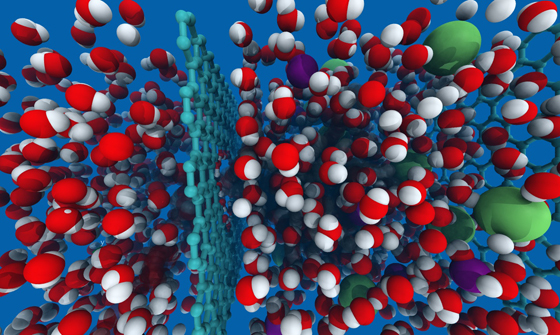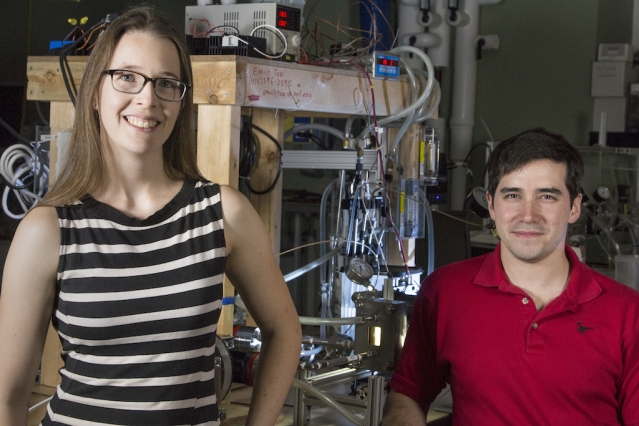
New way developed by MIT researchers to create more clean water with less energy
By: School of Engineering MIT News
November 21, 2016
With water scarcity affecting nearly 2 billion people — many of whom live near the oceans — “water, water everywhere and not a drop to drink” has become a common cry for more than just wayward sailors. Desalination through reverse osmosis (RO) has long offered one solution to help meet global water needs in the face of population growth, development, and climate change. However, removing salt from water is energy-intensive.
A team of MIT researchers has responded by creating new designs for reverse osmosis desalination that significantly exceeds the energy efficiency of state-of-the-art techniques. Instead of the standard steady flow operation, their two proposed configurations vary the salinity of a set volume of water over time, essentially providing desalination in “batches.” This batch approach could substantially reduce the energy use of future desalination systems.

PhD candidate Emily Tow (left) and postdoc David David Warsinger co-led a study proposing new designs for reverse osmosis desalination that significantly exceed the energy efficiency of state-of-the-art techniques. An experimental prototype is behind them. Photo: John Freidah/Department of Mechanical Engineering
The team is co-led by two MIT mechanical engineers, PhD candidate Emily Tow and postdoc David Warsinger, and also includes MIT PhD student Kishor Nayar, Stanford University graduate student Laith Maswadeh ’15, and John H. Lienhard, the Abdul Latif Jameel Professor of Water at MIT. The study was published in the journal Water Research and presented at the 9th International Desalination Workshop held in Abu Dhabi this week, where Warsinger won the Best Oral Presentation Award for his talk on the team’s work.
“In traditional RO systems,” explains Warsinger, “the entire system is maintained at a steady, high pressure to be able to reach the desired level of water recovery.” Specifically, saline water (the feed solution) is pumped through a membrane that passes water but blocks salts and other impurities. As water permeates through the membrane the feed solution becomes more concentrated. Due to osmosis, additional pressure is required to force water out of a more concentrated solution.
“The commercially-available semi-batch design, called closed-circuit reverse osmosis, or CCRO, recycles the concentrate into the feed stream, so that the feed solution becomes concentrated over time, and pressure in the system can be increased incrementally as needed,” Warsinger adds.
A fully batch design, as proposed by the team, has the potential to push the efficiency even higher by using a closed feed tank to reduce the amount of mixing between the recycled concentrate and feed. “Mixing causes entropy generation, which is the enemy of efficiency. Our model shows how reduced mixing in batch RO improves energy efficiency over CCRO by up to 20 percent,” says Tow. “Compared to conventional RO systems, the batch configuration provides up to 64 percent energy savings.”
The trick is in the timing. The proposed configuration can ramp up the pressure over time to precisely follow the osmotic pressure of a concentrating batch of salt water. To conserve energy, the first new configuration uses part of the RO module as a storage tank, while the other configuration uses a pressure exchanger to enable saltwater storage atmospheric pressure.
“The batch system starts with a fixed amount of solution in a circulation tank and passes it multiple times through the RO membranes to collect clean water,” Wasinger says. “With each pass, the concentration of the remaining solution increases and the pressure of the system increases to match its osmotic pressure. This gradual increase eliminates the excess energy needed to maintain the entirety of a continuous system at a high pressure.”
With practicality in mind, the team’s designs avoid the use of a pressurized circulation tank. One design takes advantage of a rotary pressure exchanger to pressurize the salt water flowing into the reverse osmosis membrane by depressurizing the concentrated brine leaving the module. An alternative design pumps permeate into a flexible bladder within the pressure vessel that contains the membranes, eliminating the need for a pressure exchanger and enabling small-scale operation.
“The energy required for seawater desalination has been reduced by a factor of four in the last three decades through advances in energy recovery devices and membrane designs, approaching the thermodynamic minimum for conventional continuous reverse osmosis processes,” says Richard L. Stover, a water industry veteran with 25 years of commercial and technical experience and a director of the International Desalination Association. “However, recent research and field trials have shown that batch and semi-batch processes have the potential to provide additional energy savings of up to 25 percent. In addition, these new processes can use advanced high-permeability membranes, such as graphene, better than continuous processes can, providing additional energy savings. For these reasons and more, batch and semi-batch processes are the future of RO.”
The authors have applied for patents on their batch systems and see potential applications for industry in the near future. As well as saving energy in large facilities, the more efficient and low-maintenance design could be very useful for smaller scale systems in off-grid areas, and could be run off of portable generators or solar power.
This research was completed at the MIT Rohsenow Kendall Heat Transfer Lab and funded as part of a joint collaboration between the Masdar Institute in Abu Dhabi and MIT.







Leave a Reply